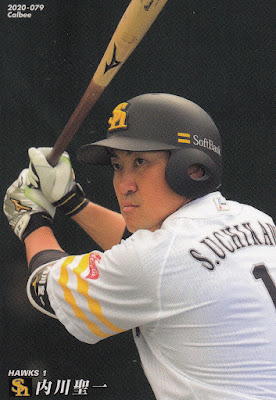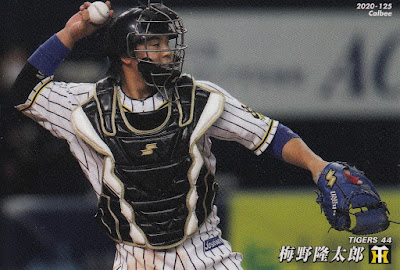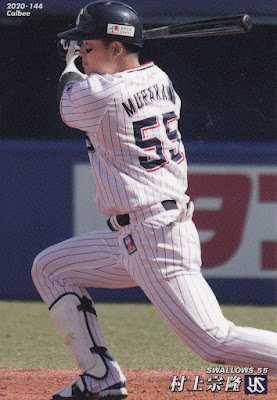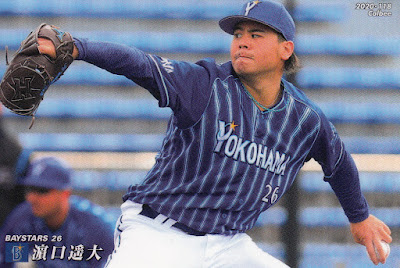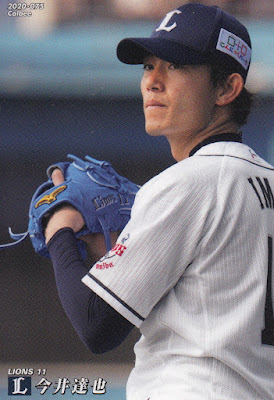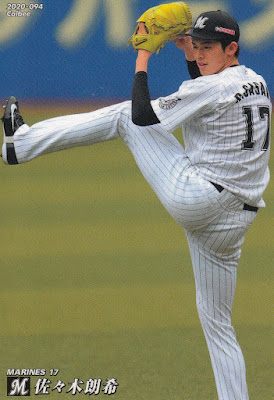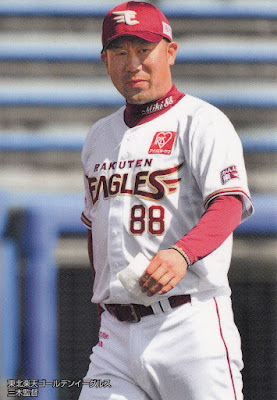Former Red Sox pitcher Junichi Tazawa was in the news recently
after he signed a deal to play for the Saitama Musashi Heat Bears of the independent Baseball Challenge (BC) League. Tazawa had been a corporate league player for Nippon Oil and was a top prospect going into the 2008 NPB draft but he requested that no Japanese team draft him as he wanted to play in the US. No NPB team drafted him and he signed a contract with the Red Sox in December of 2008. In retaliation the NPB teams passed the so-called "Tazawa Rule" which prohibits any amateur player who signs overseas from joining an NPB team until he had "sat out" for two (college and corporate league players) or three (high school players) years. If playing for a Japanese independent team qualifies as "sitting out" then Tazawa would be eligible to join an NPB team at the end of next season. There's a twist, however, as I believe that Tazawa would not be considered a free agent and at age 35 would be subject to the NPB draft.
I knew there were players who had started their professional career in the US and had been drafted by NPB teams when they returned to Japan but I wasn't sure how many there were. There were about five I came up with pretty easily (Mac Suzuki, GG Satoh, Michael Nakamura, Tetsuya Yamaguchi and Kazuhito Tadano) but when I actually sat down to do some research, I came up with 15(!). I'm pretty confident that I didn't find everyone and this doesn't include guys who started their professional career in Taiwan like Tetsu Yohfu. Here's a card and quick blurb about the guys that I did find - I used the player's Rookie Edition card if there was one (keeping in mind that BBM didn't start doing the Rookie Edition sets until 2003):
 |
| 1999 BBM #496 |
Kota Yoshida signed a deal with the Oakland Athletics after graduating from high school and spent 1997 in Arizona playing for the A's Rookie League team there. He hit .238 in 48 games and was released (I think) after the season. He was drafted by Kintetsu in the eighth round of the 1998 draft. He spent three years with the Buffaloes and got into only one game at the
ichi-gun level. He spent 2002 with Yokohama and then retired.
 |
| 2001 BBM #509 |
Takaeshi Kanaya joined the Boston Red Sox after graduating from high school and hit .313 in 14 games with the Sox' Gulf Coast League team in 1999. He returned to Japan the following year and was drafted in the sixth round of the 2000 draft by the Buffaloes. He only spent one season with them and never left the farm team. After Kintetsu released at the end of the 2001 season he signed on with the NTT Shin-Etsu club team and played for them for four years.
 |
| 2001 BBM #309 |
Osamu Tsujita was a high school teammate of Kosuke Fukudome's at PL Gakuen and attended Toyo University. If I'm understanding the translation of
his Wikipedia page correctly, it looks like he dropped out of college to somehow wrangle a deal with the Tampa Bay Devil Rays through the TV show "
Asayan" that appears to be some sort of Japanese version of "Star Search". He spent the 1998 season (Tampa Bay's inaugural season) with the Rays' Gulf Coast League team and hit .288 in 41 games. Not sure what he did in 1999 and 2000 but he was drafted by the Dragons in the eighth round of the 2000 draft which reunited him with Fukudome. He spent two seasons on the Dragons' farm team before being released after the 2002 season and he played for a couple club teams afterwards. I'm a bit amused by some of the text on the back of his card - it mentions that Hiromitsu Ochiai had also dropped out of Toyo University to become a baseball player. The similarities ended there.
 |
| 2003 BBM Rookie Edition #85 |
Makoto "Mac" Suzuki had one of the most unlikely and unusual baseball careers. He got expelled from high school in the early 90's and his parents sent him to work for family friend Don Nomura's team in the California League in the US, the Salinas Spurs. He spent 1992 as the team's laundry boy but pitched in the team's final game that year - actually the team's final game ever as they moved to San Bernardino the following year. Suzuki became a relief pitcher for San Bernardino in 1993 and was signed by the Mariners after the season. He became only the third ever Japanese major leaguer (and first one in the American League) when he made his big league debut in 1996. He also spent time playing for the Royals, Rockies and Brewers over the next few years before trying his luck back in Japan. He was drafted in the second round by the Orix BlueWave in 2002 and spent three seasons with them. He kicked around a bit after Orix released him after the 2005 season, spending time in Mexico, Taiwan and various independent league teams in both North American and Japan before retiring as a player in 2011.
 |
| 2003 BBM Rookie Edition #89 |
Daisuke Shioya dropped out of Asia University to play ball for the Frontier League's Johnstown Steal in 1998. He ran up an ERA of 5.14 in four games before getting released. He failed in tryouts with NPB teams for a number of years before Orix saw something they liked in 2002 and drafted him in the seventh round. He, like Suzuki, only spent three seasons with the team (all on the farm team) before getting released although Shioya's post NPB career seems to have only been with a club team.
 |
| 2003 BBM Rookie Edition #62 |
Nobutoshi Ido played for Sumitomo Metal of the corporate leagues for a couple years after graduating from Tokuyama University. He signed a deal with the Chicago White Sox and spent 2002 in Arizona with their rookie league team, hitting .245 in 21 games. He returned to Japan and passed the Buffaloes test so they drafted him in the ninth round of the 2002 draft. He spent two seasons with Kintetsu and became an Orix Buffalo when the two teams "merged" in 2005, joining Suzuki and Shioya. He also joined those two in getting released after the 2005 season (like Shioya having never gotten into an
ichi-gun game) and went on to coach for a club team.
 |
| 2004 BBM Rookie Edition #13 |
Takahiko "G.G." Satoh signed a contract with the Philadelphia Phillies after graduating from Hosei University in 2000. He spent three years total in their system, playing in Batavia in 2001 and 2002 and Lakewood in 2003. He hit .259 in 170 games over that time. He was released by the Phillies after the 2003 season, returned to Japan and had a tryout with the Lions. He was drafted by them in the seventh round of the 2003 draft and spent the next eight seasons with them, making the All Star team in 2008 as well as the Beijing Olympic team. He spent 2012 playing for Fortitudo Bologna in Italy and then finished his playing career with the Chiba Lotte Marines in 2013-14.
 |
| 2004 BBM Rookie Edition #7 |
Kazuhiro Takeoka spent a couple years playing for IBM Japan Yasu of the corporate leagues and the Nakayama club team after graduating from Kinki University. He somehow wrangled a contract with the Atlanta Braves out of this and spent 2001-03 bouncing between their Double-A team in Greenville and their Triple-A team in Richmond. He went 9-7 with an ERA of 3.70 in 188 games in relief. The Braves released him in mid-2003 and he joined the St Paul Saints in the independent Northern League, putting up an ERA of 7.56 in two starts. He returned to Japan and was taken by the Hawks in the eighth round of the 2003 draft. He spent five seasons with Fukuoka, mostly working out of the bullpen and joined a club team after he was released after the 2008 season.
 |
| 2005 BBM 1st Version #118 |
Michael Nakamura holds a dual citizenship since his father is Japanese and his mother is Australian. He was born in Nara, Japan but moved to Australia when he was three. He went to college in the United States at the University of South Alabama and signed with the Minnesota Twins as an amateur free agent in 1997. He spent six seasons in the Twins' organization, moving up through their minor league system until he reached the major leagues for 12 games in 2003. He was picked up off waivers by the Toronto Blue Jays in early 2004 and appeared in another 19 games in the big leagues. He was released after the season and made his way to Japan. He had a tryout with the Hokkaido Nippon-Ham Fighters that went well but since he was a Japanese citizen he was subject to the draft. The Fighters were able to take him in the fourth round of the 2004 draft and he spent the next four seasons with them (leading the Pacific League in 2006 with a then-record 39 saves) before he was traded to the Yomiuri Giants after the 2008 season. He spent three years with the Giants before joining the Lions for the 2012 season after being released by Yomiuri. He did not have a card in the 2005 Rookie Edition for reasons that are not entirely clear to me but he did have
a "bonus" Rookie Edition card issued with an issue of Sports Card Magazine.
 |
| 2006 BBM Rookie Edition #95 |
Hiroyuki Iida was another graduate of Tokuyama University and signed with the Minnesota Twins. He spent 2003 with Elizabethton of the Appalachian League going 1-0 with a 4.80 ERA in 18 games, all but one in relief. He missed the 2004 season due to a shoulder injury and was released in March of 2005. He ended up being taken by the Carp in the fifth round in the 2005 draft but re-injured his shoulder in 2006 and spent the entire year on the farm team. He got released at the end of the season but was brought back by the Carp as an
ikusei player for 2007. He tried switching to being a side-armer but he never made his way back to the 70 man roster and retired after being released again at the end of the season.
 |
| 2007 Giants Original Baseball Card #102 |
Tetsuya Yamaguchi arguably had the best NPB career of any player on this list. After being the ace pitcher at Yokohama Commercial High School he signed a deal with the Arizona Diamondbacks and spent three seasons with their Pioneer League team the Missoula Osprey, going 7-13 with a 4.98 ERA in 49 games split almost evenly between starting and relieving. He had tryouts with Yokohama, Rakuten and Yomiuri after returning to the US and the Giants took him as their first (and only) pick in the
ikusei portion of the 2005 draft. He was registered to the official 70 man roster in 2007 and was the Central League Rookie Of The Year in 2008. He played with the Giants until retiring after the 2018 season, leading the Central League in "Middle Relief" three times and making the All Star team five times. He also pitched for the Japanese team in both the 2009 and 2013 World Baseball Classics. He's become a coach for the Giants after retiring. He did not have a card in the 2006 Rookie Edition set because BBM did not start including cards for
ikusei players until 2009, probably not coincidentally the year after Yamaguchi was the first former
ikesei player to be Rookie Of The Year.
 |
| 2008 BBM Rookie Edition #42 |
Kazuhito Tadano had been a collegiate star at Rikkio University of the Tokyo Big Six league and was expected to be a top pick in the 2002 draft but it was revealed that he had starred in a gay porn video a few years earlier and none of the NPB teams wanted anything to do with him. He went to the US and signed a deal with the Indians. He spent three years in the Indians organization (2003-05) and pitched in 15 games in the major leagues in 2004 and 2005, going 1-1 with a 4.47 ERA. The Tribe traded him to Oakland at the beginning of the 2006 season and he spent most of the season with their Triple-A team in Sacramento. He returned to Japan after the minor league season ended and pitched for the Tokushima Indigo Socks of the independent Shikoku Island League for a few weeks (although still under contract to the Athletics). He split the 2007 season between Sacramento and Double-A Midland before being released by Oakland when the season ended. He was the first round pick of the Fighters in the college/corporate league player portion of the 2007 draft (although only after the Fighters had selected and lost via the lottery Shota Ohba and Yasutaka Hattori) and spent seven years with them. After Nippon-Ham released him in 2014 he spent three years as a player/coach for the Ishikawa Million Stars of the BC League before becoming a scout for the Fighters in 2017.
 |
| 2011 BBM Rookie Edition #078 |
Keisuke Ueno dropped out of Jobu University in 2004 in an attempt to join the Florida Marlins. Visa issues prevented him from being able to sign with the Marlins and he ended up spending 2005 playing for the Japan Samurai Bears, a traveling team in the independent Golden Baseball League that was made up of Japanese players and managed by former Yomiuri Giant Warren Cromartie. Despite going 1-6 with a 6.75 ERA in 18 games he was picked up by the Texas Rangers and spent the next three seasons in their organization. He went 5-8 with an ERA of 3.97 in 57 games between Arizona (2006); Spokane, WA (2007) and Clinton, IA (2008). The Rangers released him in early 2009 and he joined the Kagawa Olive Guyners of the Shikoku Island League. I don't believe that he was subject to the the "Tazawa Rule" since he'd signed with Texas before it was in effect but in any case he spent two seasons with Kagawa before being taken by the Swallows in the second round of the 2010
ikusei draft. The Swallows released him after two years in which he did not make it to the 70-man roster and after an unsuccessful tryout in Taiwan he retired.
 |
| 2017 BBM Rookie Edition #074 |
Jen-Lei Liao was born in Taiwan and moved to Japan to play high school baseball. He returned to Taiwan to go to college and signed a minor league deal with the Pittsburgh Pirates while still a college student. He spent 2014 and 2015 with the Pirates' Gulf Coast League team, going 2-3 with a 4.54 ERA in 27 games. I think he was released by the Pirates after 2015. He graduated from college in 2016 and decided to try to play in NPB. Because he had spent three years enrolled in a Japanese High School he was considered a Japanese player and was therefore subject to the draft. I am not sure why the "Tazawa Rule" does not appear to have been enforced in his case. The Giants took him in the seventh round of the 2016 draft. He spent two years with Yomiuri's farm team before being released. The Saitama Seibu Lions picked him up for 2019 and he got into three games with the top team but was again released at the end of the season. He returned to Taiwan and spent the first half of this year on the China-Trust Brothers' practice squad (his younger brother Liao Yi-Chung plays for the Brothers) and
was a first round pick of the Wei Chuan Dragons in the 2020 CPBL draft (held today).
 |
| 2018 BBM Rookie Edition #114 |
Takumi Numata dropped out of Nagoya Sangyo University to join the Edion AIT OB BLITZ club team. He signed a contract with the Los Angeles Dodgers in 2013 and apparently violated some rule with the Japan Amateur Baseball Association (JABA) that oversees corporate league and club baseball teams and earned himself a lifetime ban from playing for any JABA teams. He spent 2014 playing for the Dodgers' Arizona Rookie league team and was promoted to their Pioneer League team in Ogden, Utah for the 2015 season but was released before he could make an appearance with them. His final numbers in the Dodgers' organization was 1-2 with an ERA of 5.46 in 10 games (including 7 starts). He finished 2015 playing for the Gunma Diamond Pegasus of the BC League and spent 2016 with them as well. Apparently the Baystars considered drafting him but were prevented from doing so by the "Tazawa Rule". He joined the Ishikawa Million Stars in 2017 and was drafted in the eighth round of the 2017 draft by the Swallows. He spent most of the 2018 and 2019 seasons with Yakult's farm team (he made one appearance at the
ichi-gun level in 2018) and then was released. He signed with the Ryukyu Blue Oceans, the new independent team in Okinawa for the 2020 season.



























